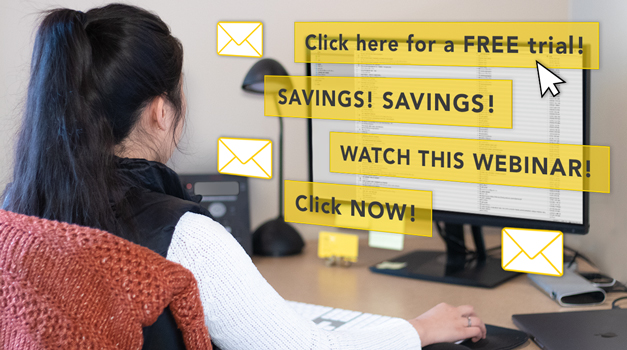RE: Concerning Subject Lines
We’ve all done it: Scrolling through our inboxes, we delete any email with subject lines that scream things such as “Watch this webinar!” and “Click here for a FREE trial!” Then there are those subject lines that are so uninteresting, your eyes glaze over: “Following up on last week’s meeting,” and “FWD: You’re invited to the next conference on the importance of market strategy.” So how do you make your messages stand out?
There should be a balance between creating excitement and being straight to the point. But finding that balance takes trial and error… and strategy. Cloud computing company Salesforce reports that 64 percent of recipients decide to open emails solely on subject line content.1 Now is the time to strategize.
It’s especially important to be brief in an era when most people read emails on their phones. According to a survey conducted by Return Path, fifty-five percent of people read emails on their phones—up from 29 percent in 2012.2 And no matter the device, an email’s subject line in this format is condensed, making its content essential.
Keeping that in mind, here are a few suggestions for how you can optimize open rates on your emails:
Think of your subject lines like tweets.
Remember when Twitter only allotted 140 characters per tweet? Sure it was challenging at first, but eventually, it got easier creating punchy messages. We recommend that you restrict yourself to somewhere around 35 characters (50 max), no matter the message. Not only is this length optimal for mobile, but you’ll keep audience attention too. Forcing yourself to stay within a set of boundaries will be challenging, but it will produce more creativity and make the subject line concise and to the point. Your audience should not get the entire message before opening the email itself.
Using emojis in subject lines can help cut down on character count. Incredibly cute and expressive, emojis are a unique way to quickly get your point across and grab the audience’s attention—when used sparingly, of course. Emojis should be relevant to your message, such as a plane for a message about a trip sweepstakes or confetti for messaging about the new year, or relevant to your brand for higher click-through rates. If you decide to use emojis, it’s important that you test them on multiple platforms—Gmail, Apple Mail, and Outlook (among others) each render emojis differently. Emojis also look different on Apple and Android devices, so conducting these tests will help make sure your subject line’s message remains consistent throughout.
Avoid spammy words and overused phrases.
Sales productivity platform Yesware reports that phrases such as “join us for,” “webinar,” and “you’re invited to” show low open rates and even lower click-through rates.3 Think of how often you see these words. Are you intrigued? Do you need to learn more? We doubt it. If you’re not interested, your audience won’t be interested, so avoid using these well-worn phrases.
Additionally, avoid using words that email platforms track as spam—including the word “avoid”! Platforms will delete emails with subject lines using words and phrases such as “free installation,” “success,” “urgent,” and “important.” You definitely won’t achieve a good response if your audience doesn’t even receive the email.
Try integrating phrases that imply action on your (or your company’s) part. “Confirming,” “next steps,” and “status of” not only increase the chances of an open but also increase the chance of a reply or action from the audience.
Flatter your audience.
Everyone likes compliments. The positive feelings produced by flattery will boost your audience’s mood, build their confidence, and create a favorable relationship with your company. Once empowered by your message, readers are more likely to make a purchase or otherwise engage with your brand. The simple “thank you” email is a great example. Loyal customers—and those simply looking to learn more about your brand—thanked for doing business with you or clicking through an email for more information are more likely to engage with you again if they feel appreciated.4
Finding the right balance of brief, informative, exciting, and complimentary subject lines is hard, so test a few methods to find what works best for you and your business. We can help you create these strategies, draft some samples, and analyze the results. Let’s start that thread.
SOURCES:
1https://www.lyfemarketing.com/blog/email-subject-line-best-practices/
2https://returnpath.com/newsroom/mobile-now-preferred-platform-reading-email-half-email-opens/
3https://www.yesware.com/email-subject-lines/
4https://www.inc.com/larry-alton/how-to-flatter-your-target-audience-and-why-you-should.html
